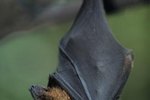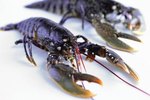
When you accidentally stepped on that grasshopper outside, you may have heard a "crunch" and cringed, thinking about broken bones. The bad news is the bug probably didn't survive your foot, but it wasn't because his bones were broken. Insects don't have bones; instead, their limbs and wings are made of cuticle.
Insect Cuticle
Wings, legs, joints -- all these parts of an insect are made of insect cuticle, a substance that's actually much tougher than bone. It's not made of cells, like your skin is, but instead is more like your fingernail, made mostly of proteins secreted by underlying cells. The secreted proteins are supported by chitin, a natural polymer that provides the cuticle's strength and prevents tearing. Different parts of the insect have different proteins, so the cuticle's strength changes according to body part.
Tough Yet Flexible
Though it's tempting to imagine an insect's life as an easy one, all insects put their bodies through a great deal of stress. They don't just hang out on foliage all day. Insects jump, take off and land, and flutter their wings throughout the day as they look for food and evade potential predators. Their cuticle composition gives them durability and flexibility, allowing them to do these movements repeatedly and effortlessly throughout their lives.
Veins: Cuticle's Helper
A moth's wing looks as if it would tear as easy as tissue paper, but cuticle helps the wing maintain its integrity. However, a wing's membrane isn't as tough as cuticle elsewhere in an insect's body. A 2012 study in the scientific journal PLoS ONE noted the cuticle in grasshopper legs is one of the most durable natural materials in the world. However the cuticle in insect wings is different, and not as strong as in other body parts. But that's OK because a network of veins in insect wings work as reinforcement to help keep wings from cracking.
A Fine Balance
A network of veins and the cuticle work together to give insect wings ultimate protection. If a wing experiences a crack, the crack stops when it encounters a cross vein, which acts as a barrier for further cracking. According to the study, these barriers increase insect wing toughness by 50 percent. In theory, it would make sense for the wing to be filled with veins and made of more durable cuticle to make those wings impenetrable. However, wings need to be light. Nature found the correct balance for insect wings; they're light enough for flying, but strong enough to last a lifetime.
References
- Concise Encyclopedia of Composite Materials, Andreas Mortensen
- North Carolina State University: General Entomology ENT 425: External Anatomy: Wings
- Science Daily: Transparent, Thin and Tough: Why Don't Insect Wings Break?
- University of Minnesota Department of Entomology: Ent 4015 Ornamentals and Turf Entomology -- Insect Morphology
- PLoS ONE: Veins Improve Fracture Toughness of Insect Wings
- The Journal of Experimental Biology: Insect Cuticle Tougher Than Bone
- Living With Insects Blog: The Insect Cuticle
Photo Credits
-
Jeffrey Hamilton/Photodisc/Getty Images




